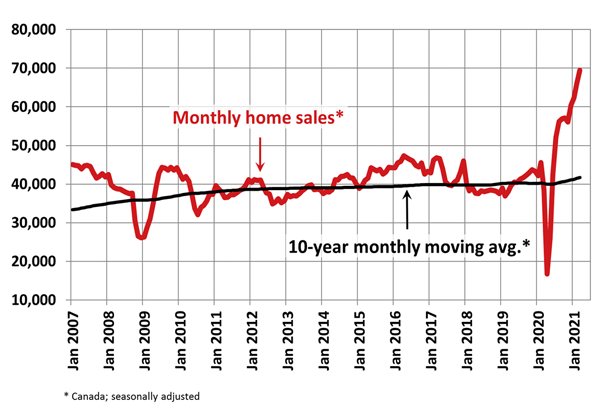OTTAWA, Ontario Friday, April 16, 2021) — National home sales set another all-time record in March 2021, increasing by 5.2 percent over February, in spite of an increase in listings, according to statistics released, yesterday, by the Canadian Real Estate Association (CREA).
In the face of continuing strong demand, the month-over-month increase in national sales activity, from February to March, was broad-based and generally in line with locations, where more new listings became available.
March sales gains were largest, in Greater Vancouver, Calgary, Edmonton, Hamilton-Burlington and Ottawa.
Actual (not seasonally adjusted) sales activity posted a 76.2 percent gain over March 2020, “although year-over-year comparisons will be extremely stretched this spring, because of last year’s initial lockdown period”, CREA noted.
In line with heightened activity, since last summer, sales set a new record for the month of March, by a considerable margin (almost 22,000 transactions). In fact, the 76,259 residential properties that traded hands, via CREA’s MLS Systems in March 2021, marked the highest level of activity of any month in history, nearly 14,000 more sales than the previous record, set last July.
“Seeing how many homes were bought and sold in March 2021, one could be forgiven for thinking the market just continues to strengthen, and maybe to some extent it is,” stated Cliff Stevenson, Chair of CREA.
“The real issue is not strength in housing markets, but imbalance. That demand has been around for months, but with the shortages in supply we have, across so much of Canada, a lot of that demand has been pressuring prices. So the big rebound in new supply to start the spring market is the relief valve we need the most, to get that demand playing out more on the sales side of things, and less on the price side.
“That said, it will take a lot more than one month of record new listings, but it looks like we may finally be rounding the corner on these extremely unbalanced housing market conditions,” explained Stevenson.
The number of newly listed homes climbed a further 7.5 percent to set a new record in March and, together with February’s big rebound, new supply is up more than 25 percent in the last two months.
“With the rebound in new supply outpacing recent gains in sales, the national sales-to-new listings ratio eased back to 80.5 percent in March, compared to a peak level of 90.9 percent set in January. The long-term average for the national sales-to-new listings ratio is 54.4 percent, so it is currently still very high historically, and the good news is, it appears to finally be moving in the right direction,” CREA reported.
Based on a comparison of sales-to-new listings ratio with long-term averages, less than 20 percent of all local markets were in balanced market territory in March, measured as being within one standard deviation of their long-term average. The other 80+ percent of markets were above long-term norms, in many cases well above, the Association added.
The number of months of inventory is another important measure of the balance between sales and the supply of listings. It represents how long it would take to liquidate current inventories at the current rate of sales activity.
There were only 1.7 months of inventory on a national basis, at the end of March 2021 – the lowest reading on record for this measure. The long-term average for this measure is a little over five months.
“We spent a lot of time, over the last year, talking about pent-up demand, but I think now is a good time to talk about pent-up supply, which may be the answer to the question everyone is asking right now,” said Shaun Cathcart, CREA’s Senior Economist.
“2020 was the year that home became everything, so, in hindsight, it’s not that surprising that so many people, who did not have one in which to ride out the pandemic, really wanted one, while so many of those who did have a home to hunker down in, were not inclined to give it up. It stands to reason then, that as the uncertainty caused, and danger posed, by COVID, wind down, some owners, who would not sell during a global pandemic, will emerge with properties for sale, while at the same time, some of the urgency on the demand side, could dissipate.
“We’ll only know in the fullness of time, but March certainly did nothing to disprove the idea. That said, the third wave of COVID-19 could throw a wrench into the works of a potential supply recovery this spring,” cautioned Cathcart.
Home prices climbed by 3.1 percent in March, compared to February – similar to, but slightly less than, the record gain in February.
While price growth remains largest in the single-family home space, the pace of those gains decelerated in March, while price gains in the more affordable townhome and apartment segments continued to pick up steam. Of the 41 markets now tracked by the index, all but one were up on a m-o-m basis.
The actual (not seasonally adjusted) national average home price was a record $716,828 in March, up 31.6 percent from the same month last year. That said, it is important note that the biggest increase in new supply and thus sales in March was in Greater Vancouver, which raised that market’s share of national activity to its highest level in almost four years.
The national average price is heavily influenced by sales in Greater Vancouver and the Greater Toronto Area, two of Canada’s most active and expensive housing markets. Excluding these two markets from calculations, cuts more than $160,000 from the national average price.
 Pride News Canada's Leader In African Canadian & Caribbean News, Views & Lifestyle
Pride News Canada's Leader In African Canadian & Caribbean News, Views & Lifestyle






